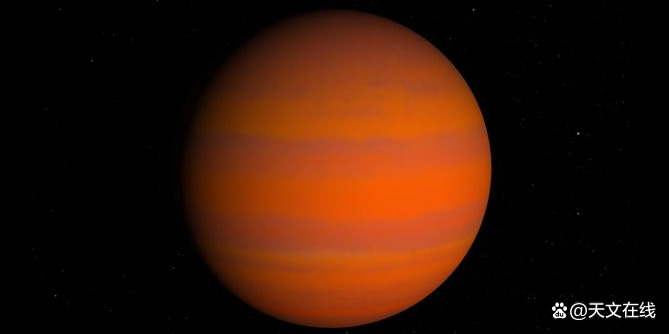Strange, hot, outer planet wasp-76b may be hotter than we think
Author:Astronomy online Time:2022.08.27
Explore a planet with "iron rain"
4350 Hua Shi is not hot enough for you?

This artist's illustration shows the night view of the exterior planet Wasp-76B. This huge exterior planet has a temperature of more than 4350 (2400 degrees Celsius) during the day, which is enough to evaporate metal. The strong wind brought the iron steam to a cold night, where it was condensed into an iron drop. (Picture source: ESO/M. Kornmesser)
The outer planet WASP-76 B may be hot-more hot than scientists-this does show some things.

WASP-76 B is about 640 light years from the sun. It is a "ultra-heat Jupiter", flying around its mother star every 1.8 earthly day. The extreme close to this star has turned this giant star into a strange hell world, and there is no planet in our own solar system.
For example, a large amount of star radiation absorbed by WASP-76 B has greatly expanded this outer planet. Its width is 1.85 times that of Jupiter, and it only has 85%of Jupiter's mass. WASP-76 B is also locked by the tide, always showing the same side to its stars, just like the moon shows only its close side to the earth.

WASP-76 B is very hot. Astronomers estimate that its night temperature is 2370 (1300 degrees Celsius), and its daytime temperature is about 4350 (2400 degrees Celsius) -The heat is enough to evaporate many metals. In fact, scientists believe that the strong wind brings the evaporated iron from the planet's sun to a cold night side, where it is condensed and fell in the form of "iron rain".

However, the new research report shows that WASP-76 B may be more extreme than previous studies. Some scientists used Gemini northern telescopes near the top of the Monakian volcano mountain in Hawaii to observe the exogenous planet and found the characteristics of ionizing calcium (a charging form of an element) in its high -level atmosphere.
"We have seen a lot of calcium, which is a very important feature." Emily Dubet, a doctoral student at the University of Toronto, said in a statement.

"This spectral characteristics of ionizing calcium may indicate that this layman star has a very strong high -level atmosphere," she said. "Or its atmospheric temperature is much higher than expected."
Donbert is the main author of the WASP-76 B new research report. The research was published online on October 5, 2021 on the "Celestial Physics Magazine Express". You can read its pre -printed book for free in Arxiv.org. Researchers also showed their research results at the 53rd meeting of the Planet Science Department of the American Astronomical Association.

This new study has not speculated that the temperature of WASP-76 B may be much higher, but let us further realize that the galaxy is a very diverse place, and there are all kinds of magical planets everywhere. In the past ten years, astronomers have begun to enjoy the whole picture of this planet. As we explore space more and more sharply, I believe there will be more surprises.
"When dozens of ex -planets of different quality and temperatures are remotely sensitive, we will better understand the true diversity of alien world, from planets that are enough to accommodate iron rain to other mildly climatic planets." New York New York Professor of astronomy at the University of Isaaconnell, the co -author of the study, Lei Jaa Vadhana, said in the same statement:
"It is worth noting that using today's telescope and instruments, we can already learn a lot of planet atmosphere running around hundreds of light years, including ingredients, physical characteristics, clouds, and even large -scale winds." Jia Avardanna said.

related information
WASP-76B is a giant giant exogenous planet running around the F-type main sequence star. It was discovered by the researcher on the Southern Observatory of Europe in 2016.
The solar system is a planetary system that is constrained by the solar gravity, including the sun that directly or indirectly surrounds the sun. Among the celestial bodies that directly surround the sun, the largest eight are known as the planet, and the rest of the celestial bodies are much smaller than the planets, such as dwarf planets, solar asteroids and comets. The celestial body that indirectly surrounds the sun is a satellite, and two of them are larger than the smallest planet Mercury.

Planets of the solar system, or exorcotomy for short, are planets located outside the solar system. As of October 20, 2021, a total of 4,531 exterior planets that have been confirmed, about three -quarters of them were discovered through the phenomenon of Lingri. These planets are divided into 3364 planetary systems, of which 778 multi -planets. The Cairple mission has detected 18,000 star candidates, including 262 candidates located in the potentially suitable ribbon.
By: Mike Wall
Fy: Yang Fan
If there is related content infringement, please contact the author to delete after the work is released
Reprinted, please obtain authorization, and pay attention to maintaining integrity and indicating the source
- END -
The master of the fried fritter may be an expert in fluid mechanics

Each bite is made of different sounds such as crickets, bangs, hissing, crackling,...
The genetic clues of dogs and friends are discovered
According to a study released on the 9th on the 9th, the melanin cortexy-2 (MC2R) gene may play a role in the domestication of dogs, so that they develop social cognitive skills, and and and and and